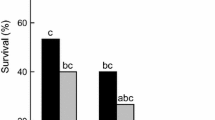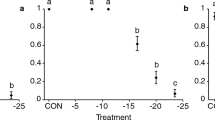Abstract
Supercooling points were estimated for seven populations of >Aphelinus albipodus, five populations of >Aphelinus asychis, and four populations of >Diaeretiella rapae to assess whether their supercooling points were sufficiently low to provide the potential for overwintering survival in colder temperate climatic areas. Test individuals from all 16 of the parasitoid populations were collected originally from mummies of the Russian wheat aphid, >Diuraphis noxia. Mummies containing parasitoid pupae were maintained for 1 wk under three different temperature conditions (treatments): at room temperature (24.8 ± 0.2 °C), 1 wk at 0 °C, and 1 wk −5 °C, and the supercooling points across treatments, and within and among species were compared. Statistical differences in supercooling points were found among populations of >A. albipodus for each treatment, and for >A. asychis when maintained for 1 wk at room temperature. No differences in supercooling points were found among populations of >D. rapae mummies maintained under the three temperature treatments. The lowest supercooling points obtained for the three parasitoid species maintained at room temperature were the >A. albipodus population from Montana (−31.68 °C), the >A. asychis population from Greece (−32.04 °C), and the >D. rapaepopulation from the Caucasus (−33.12 °C). Preconditioning the parasitoid mummies to cold had no effect on the supercooling points for >A. albipodus, and in some cases unexpectedly increased the supercooling points for >A. asychisand >D. rapae. In comparing the overall mean supercooling points of the three parasitoid species, no differences were found within species (among temperature treatments), nor among species (within temperature treatments). It was concluded that observed differences in supercooling points of only a few degrees Centigrade among parasitoid populations and species would not be expected to cause differences in their overwintering success, especially given the expected variability in temperatures within and among overwintering sites.
Similar content being viewed by others
References
Aalbersberg, Y.K., F. du Toit, M.C. van der Westhuizen and P.H. Hewitt, 1987. Development rate, fecundity, and life span of apterae of the Russian wheat aphid, >Diuraphis noxia (Mordvilko) (Hemiptera: Aphididae), under controlled conditions. >Bull. Entomol. Res. 77: 629–635.
Bale, J.S., Rose O'Doherty, H.J. Atkinson and R.A. Stevenson, 1984. An automatic thermoelectric cooling method and computer-based recording system for supercooling point studies on small invertebrates. >Cryobiol. 21: 340–347.
Bale, J.S., 1987. Insect cold hardiness: freezing and supercooling, an ecophysiological perspective. >J. Insect Physiol. 33: 899–908.
Baust, J.G., R.E. Lee, Jr. and R.A. Ring, 1982. The physiology and biochemistry of low temperature tolerance in insects and other terrestrial arthropods: A bibliography. >Cryo. Letters 3: 191–212.
Bennett, L.E. and R.E. Lee, 1989. Simulated winter to summer transition in diapausing adults of the lady beetle (>Hippodamia convergens): supercooling point is not indicative of coldhardiness. >Physiol. Entomol. 14: 361–367.
Block, W., 1991. To freeze or not to freeze? Invertebrate survival of sub-zero temperatures. >Funct. Ecol. 5: 284–290.
Butts, R.A., 1992. Cold hardiness and its relationship to overwintering of the Russian wheat aphid (Homoptera: Aphididae) in southern Alberta. >J. Econ. Entomol. 85: 1140–1145.
Clausen, C.P., 1958. Biological control of insect pests. >Annu. Rev. Entomol. 3: 291–310.
Danks, H.V., 1978. Modes of seasonal adaptation in the insects. I. Winter survival. >Can. Entomol. 110: 1167–1205.
Danks, H.V., 1996. The wider integration of studies on insect cold-hardiness. >Eur. J. Entomol. 93: 383–403.
Duman, J.G., 1982. Insect antifreezes and ice-nucleating agents. >Cryobiology 19: 613–627.
Francke, O.F., J.C. Cokendolpher and L.R. Potts, 1986. Supercooling studies on North American fire ants (Hymenoptera: Formicidae). >Southwest Naturalist. 31: 87–94.
Good, W.R., J.M. Story and N.W. Callan, 1997. Winter cold hardiness and supercooling of >Metzneria paucipunctella (Lepidoptera: Gelechiidae), a moth introduced for the biological control of spotted knapweed. >Environ. Entomol. 26: 1131–1135.
Hart, A.J. and J.S. Bale, 1998. Factors affecting the freeze tolerance of the hover fly >Syrphus ribesii (Diptera: Syrphidae). >J. Insect Physiol. 44: 21–29.
Hofsvang, T. and E.B. Hågvar, 1977. Cold storage tolerance and supercooling points of mummies of >Ephedrus cerasicola Stary and >Aphidius colemani Viereck (Hym. Aphidiidae). >Norw. J. Entomol. 24: 1–6.
Horn, D.J., 1988. >Ecological Approach to Pest Management. The Guilford Press, New York. 285 pp.
Langer, A. and T. Hance, 2000. Overwintering strategies and cold hardiness of two aphid parasitoid species (Hymenoptera: Braconidae: Aphidiinae). >J. Insect Physiol. 46: 671–676.
Leather, S.R., K.F.A. Walters and J.S. Bale, 1993. >The Ecology of Insect Overwintering. Cambridge University Press, Cambridge. 255 pp.
Lee, R.E. and D.L. Delinger, 1985. Cold tolerance in diapausing and nondiapausing stages of the flesh fly, >Sarcophaga crassipalpis. >Physiol. Entomol. 10: 309–315.
Mason, P.G. and K.R. Hopper, 1997. Temperature dependence in locomotion of the parasitoid >Aphelinus asychis (Hymenoptera: Aphelinidae) from geographical regions with different climates. >Environ. Entomol. 26: 1416–1423.
Messenger, P.S. and R. van den Bosch, 1971. The adaptability of introduced biological control agents. In: C.B. Huffaker (ed), >Biological Control, Plenum Publishing Corp., New York. pp. 68–92.
Michels, G.J., Jr. and R.J. Behle, 1988. Influence of temperature on reproduction, development, and intrinsic rate of increase of Russian wheat aphid, greenbug, and bird cherry-oat aphid (Homoptera: Aphididae). >J. Econ. Entomol. 82: 439–444.
Morrill, W.L., J.W. Gabor and D. Wichman, 1993. Mortality of the wheat stem sawfly (Hymenoptera: Cephidae) at low temperatures. >Environ. Entomol. 22: 1358–1361.
Nechols, J.R., M.J. Tauber, C.A. Tauber and S. Masaki, 1999. Adaptations to hazardous seasonal conditions: dormancy, migration, and polyphenism. In: C.B. Huffaker and A.P. Gutierrez (eds), >Ecological Entomology, 2nd ed. John Wiley & Sons, New York. pp. 159–200.
Nowierski, R.M. and J.B. Johnson, 1995. Russian wheat aphid, >Diuraphis noxia (Mordvilko)( Homoptera: Aphididae). In: J.R. Nechols, L.A. Andres, J.W. Beardsley, R.D. Goeden and C.G. Jackson (eds), >Biological Control in the Western United States: Accomplishments and Benefits of Regional Research Project W-84 (1964–1989). Univ. Calif., Agric. And Natural Resources Publ. #3361, Oakland, CA. pp. 136–139.
Nowierski, R.M., C.B. Huffaker, D.L. Dahlsten, D.K. Letourneau, D.H. Janzen and G.G. Kennedy, 1999. The influence of insects on plant populations and communities. In: C.B. Huffaker and A.P. Gutierrez (eds), >Ecological Entomology, 2nd ed. John Wiley & Sons, New York. pp. 585–642.
Nowierski, R.M., G.J. McDermott, B.C. FitzGerald and J.M. Story, 2000. Overwintering mortality of >Urophora affinis and >U. quadrifasciata (Diptera: Tephritidae) on spotted knapweed, >Centaurea maculosa (Compositae): effects of larval competition versus exposure to subzero temperatures. >Environ. Entomol. 29: 403–412.
Salt, R.W., 1936. Studies on the freezing process in insects. >Tech. Bull. Minn. Agric. Exp. Stn. 116: 1–41.
Somme, L., 1999. The physiology of cold hardiness in terrestrial arthropods. >Eur. J. Entomol. 96: 1–10.
Stevens, L.M., A.L. Steinhauer and J.R. Coulson, 1975. Suppression of Mexican bean beetle on soybeans with annual inoculative releases of >Pediobius foveolatus. >Environ. Entomol. 4: 497–502.
Story, J.M., W.R. Good and N.W. Callan, 1993. Supercooling capacity of >Urophora affinis and >U. quadrifasciata (Diptera: Tephritidae), two flies released on spotted knapweed in Montana. >Environ. Entomol. 22: 831–836.
Strathdee, A.T. and J.S. Bale, 1998. Life on the edge: insect ecology in arctic environments. >Annu. Rev. Entomol. 43: 85–106.
Tauber, M.J., C.A. Tauber and S. Masaki, 1986. >Seasonal Adaptations of Insects. Oxford University Press, New York.
Todd, C.M. and W. Block, 1995. A comparison of the cold hardiness attributes in larvae of four species of Diptera. >Cryo. Letters 16: 137–146.
Turnock, W.J., R.J. Lamb and R.P. Bodnaryk, 1983. Effects of cold stress during pupal diapause on the survival and development of >Mamestra configurata (Lepidoptera: Noctuidae). >Oecologia 56: 185–192.
Wellington, W.G., D.L. Johnson and D.J. Lactin, 1999. Weather and insects. In: C.B. Huffaker and A.P. Gutierrez (eds), >Ecological Entomology, 2nd ed. John Wiley & Sons, New York. pp. 313–353.
Williams, K.S., 1985. Climatic influences on weeds and their herbivores: biological control of St. John's wort in British Columbia. In: E.S. Delfosse (ed), >Proc. VI Int. Sympos. Biol. Contr. Weeds. University British Columbia, Vancouver, B.C., Canada. pp. 127–132.
Author information
Authors and Affiliations
Rights and permissions
About this article
Cite this article
Nowierski, R.M., Fitzgerald, B.C. Supercooling capacity of Eurasian and North American populations of parasitoids of the Russian wheat aphid, >Diuraphis noxia . BioControl 47, 279–292 (2002). https://doi.org/10.1023/A:1014824725240
Issue Date:
DOI: https://doi.org/10.1023/A:1014824725240




